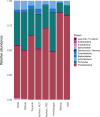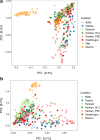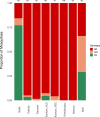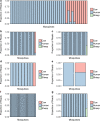Relative contributions of various endogenous and exogenous factors to the mosquito microbiota
- PMID: 33303025
- PMCID: PMC7726613
- DOI: 10.1186/s13071-020-04491-7
Relative contributions of various endogenous and exogenous factors to the mosquito microbiota
Abstract
Background: The commensal microbiota of mosquitoes impacts their development, immunity, and competency, and could provide a target for alternative entomological control approaches. However, despite the importance of the mosquito/microbiota interactions, little is known about the relative contribution of endogenous and exogenous factors in shaping the bacterial communities of mosquitoes.
Methods: We used a high-throughput sequencing-based assay to characterize the bacterial composition and diversity of 665 individual field-caught mosquitoes, as well as their species, genotype at an insecticide resistance locus, blood-meal composition, and the eukaryotic parasites and viruses they carry. We then used these data to rigorously estimate the individual effect of each parameter on the bacterial diversity as well as the relative contribution of each parameter to the microbial composition.
Results: Overall, multivariate analyses did not reveal any significant contribution of the mosquito species, insecticide resistance, or blood meal to the bacterial composition of the mosquitoes surveyed, and infection with parasites and viruses only contributed very marginally. The main driver of the bacterial diversity was the location at which each mosquito was collected, which explained roughly 20% of the variance observed.
Conclusions: This analysis shows that when confounding factors are taken into account, the site at which the mosquitoes are collected is the main driver of the bacterial diversity of wild-caught mosquitoes, although further studies will be needed to determine which specific components of the local environment affect bacterial composition.
Keywords: Anopheles; Bacterial composition; Entomological control; High-throughput screening; Microbiome.
Conflict of interest statement
The authors declare that they have no competing interests. The findings and conclusions in this report are those of the author(s) and do not necessarily represent the official position of the Centers for Disease Control and Prevention.
Figures





Similar articles
-
Western Kenyan Anopheles gambiae showing intense permethrin resistance harbour distinct microbiota.Malar J. 2021 Feb 8;20(1):77. doi: 10.1186/s12936-021-03606-4. Malar J. 2021. PMID: 33557825 Free PMC article.
-
Infection of highly insecticide-resistant malaria vector Anopheles coluzzii with entomopathogenic bacteria Chromobacterium violaceum reduces its survival, blood feeding propensity and fecundity.Malar J. 2020 Oct 2;19(1):352. doi: 10.1186/s12936-020-03420-4. Malar J. 2020. PMID: 33008454 Free PMC article.
-
Overabundance of Asaia and Serratia Bacteria Is Associated with Deltamethrin Insecticide Susceptibility in Anopheles coluzzii from Agboville, Côte d'Ivoire.Microbiol Spectr. 2021 Oct 31;9(2):e0015721. doi: 10.1128/Spectrum.00157-21. Epub 2021 Oct 20. Microbiol Spectr. 2021. PMID: 34668745 Free PMC article.
-
Mosquito Gut Microbiota: A Review.Pathogens. 2024 Aug 15;13(8):691. doi: 10.3390/pathogens13080691. Pathogens. 2024. PMID: 39204291 Free PMC article. Review.
-
The tripartite interactions between the mosquito, its microbiota and Plasmodium.Parasit Vectors. 2018 Mar 20;11(1):200. doi: 10.1186/s13071-018-2784-x. Parasit Vectors. 2018. PMID: 29558973 Free PMC article. Review.
Cited by
-
The Possible Role of Microorganisms in Mosquito Mass Rearing.Insects. 2021 Jul 15;12(7):645. doi: 10.3390/insects12070645. Insects. 2021. PMID: 34357305 Free PMC article. Review.
-
A tangled threesome: understanding arbovirus infection in Aedes spp. and the effect of the mosquito microbiota.Front Microbiol. 2024 Jan 3;14:1287519. doi: 10.3389/fmicb.2023.1287519. eCollection 2023. Front Microbiol. 2024. PMID: 38235434 Free PMC article. Review.
-
Intrinsic factors driving mosquito vector competence and viral evolution: a review.Front Cell Infect Microbiol. 2023 Dec 21;13:1330600. doi: 10.3389/fcimb.2023.1330600. eCollection 2023. Front Cell Infect Microbiol. 2023. PMID: 38188633 Free PMC article. Review.
-
Microbiota Variation Across Life Stages of European Field-Caught Anopheles atroparvus and During Laboratory Colonization: New Insights for Malaria Research.Front Microbiol. 2021 Nov 24;12:775078. doi: 10.3389/fmicb.2021.775078. eCollection 2021. Front Microbiol. 2021. PMID: 34899658 Free PMC article.
-
Mosquito Microbiome Diversity Varies Along a Landscape-Scale Moisture Gradient.Microb Ecol. 2022 Oct;84(3):893-900. doi: 10.1007/s00248-021-01865-x. Epub 2021 Oct 6. Microb Ecol. 2022. PMID: 34617123 Free PMC article.
References
-
- World Health Organization. Mosquito-borne diseases 2020. Geneva: World Health Organization. http://www.who.int/neglected_diseases/vector_ecology/mosquito-borne-dise.... Accessed 22 Feb 2020.
-
- Mulla MS. Mosquito control then, now, and in the future. J Am Mosq Control Assoc. 1994;10(4):574–584. - PubMed
-
- Riveron JM, Tchouakui M, Mugenzi L, Menze BD, Chiang M-C, Wondji CS. Insecticide resistance in malaria vectors: an update at a global scale. In: Manguin S, Dev V, editors. Towards malaria elimination—a leap forward. IntechOpen; 2018. 10.5772/intechopen.78375, Available from: https://www.intechopen.com/books/towards-malaria-elimination-a-leap-forw....
MeSH terms
Grants and funding
LinkOut - more resources
Full Text Sources

